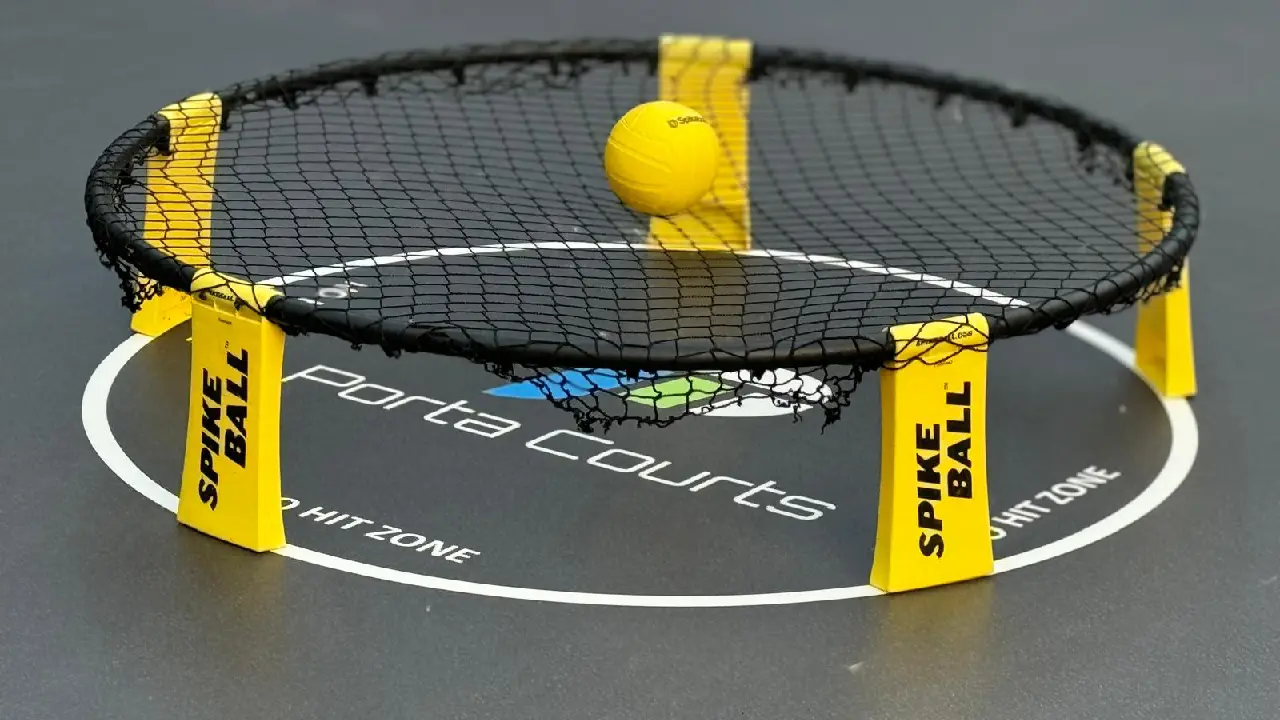How To Set Up a Spikeball Net Properly - Pro Guide!
Setting a spikeball net is crucial to ensure that the game remains fun and the competition stays fair. Mastering the correct techniques for spike ball setup is not a long and dedicated task. You need to count parameters that the net is placed on a suitable and flat floor, it is tight enough to produce the optimal bounce for fast-paced rallies. And lastly, it is placed at the exact center of the spikeball court.
In this guide, you’ll learn exactly how to set up a spikeball net—from selecting the ideal play area to ensuring every part of the spikeball setup is secure.
Find The Right Place for Proper Setup
A well-set-up Spikeball net improves game performance, prevents unnecessary interruptions, and enhances the overall playing experience. But before you proceed with the net and court, make sure that the surface you are choosing for your game time is flat and even, especially in and around the net area, rims, and legs. Incorrect Spikeball net setup can lead to uneven bounces, instability, and frustration during the game.
Think of choosing the right place before setting up as preparation for a baseball or soccer field. You might have seen how much preparation goes into making and polishing the field. Uneven or incorrect placement of spike ball court and net can result in instability, uneven bounces, or even chances of injuries. Once you have found the right ground, proceed with the net part.
How to Set Up Spikeball Net: Step-by-Step Guide
1. Sort and Assemble
First of all, unpack all the items. There should be 5 spikeball rims, 5 legs, and a net minimum. Usually, you also get at least 2 spikeballs with each spikeball kit. Now, attach the spikeball rims with legs and consecutively pair all 5 rims to form a circle.
Most of the spike ball courts are designed for quick setup, therefore you don’t require any additional tools to set up.
2. Starting with the Spike Ball Net
Once you have the frame ready, proceed with hanging your net with the rims. Pick any corner and attach the outermost thread of the net with the hook below the rim. Make sure you place the net through the top and bottom to the hook. Then choose the exact opposite corner of the net and attach it similarly.
Once you have 2 opposite sides attached, follow the same process with the corresponding sides so that you squarely attach the net, with each of the sides almost similar in terms of tension and distance to one another. Connecting the four key points first helps you to balance the net tension evenly around the frame. Now all you have to do is to secure and tighten the net.
3. Secure & Tighten the Net
Continue attaching the net with every hook of the rim in a similar fashion as earlier. Make sure the net is evenly balanced throughout the rim. The net should be tight enough to avoid pockets but not so tight that it restricts ball bounce.
To perform the final check, look for even square shapes of the net and their even distribution. If there is any stretch or unbalance, the square shape of the net would be deformed.
4 Prepare the Spike ball Court & You're Good to go
Once done with the net part, place it on the center of PortaCourts’ Spike ball court for enhanced gameplay. These courts are made to provide an enhanced experience during the long games. Our courts are designed with built-in shock-absorbing layers to enable agility and comfort even during long gameplays.
Like setting up the net correctly is important for fair gameplay, so is the knowledge of the basic rules. Learn the essential rules to the spikeball game here!
Tips for Easy Maintenance & Peak Performance During Every Game
Regular maintenance of equipment is required for smooth gameplay in every sport, as is the case with the spike ball. There are a few handy tips such as checking net tension, not leaving the net stretched for long periods, and customization as per playing environment. Here are a few tips and tricks that will keep your performance and gameplay at their best in every game.
1. Regular Maintenance: Check the Net’s Tension
Why It Matters:
Regularly inspecting your spikeball net’s tension is crucial. A net that is too loose may result in unpredictable ball bounces and create pockets that disrupt gameplay. Conversely, an overly tight net can cause the ball to rebound too sharply, affecting control during serves and returns.
How to Do It:
Before every game, visually inspect the net for any sagging or uneven tension. Run your fingers along the net’s surface to detect any soft spots or areas that seem overly tight. Adjust by re-securing the net to its hooks or using the tensioning mechanism provided with your kit. This step ensures that each session starts with the ideal net firmness for an optimal spikeball setup.
2. Storage Tips: Avoid Leaving the Net Stretched for Long Periods
Preventing Deformation:
Continuous tension on the net, especially when not in use, can cause the material to stretch or even become deformed. Over time, this not only affects the bounce of the ball but also reduces the overall lifespan of the net.
Practical Storage Solutions:
After playing, consider loosening the net slightly or detaching it from the frame if your spikeball set allows. Store the net in a cool, dry place away from direct sunlight to preserve its elasticity. Following these storage tips will help maintain the net’s performance, ensuring a consistently excellent spikeball setup.
Fun Fact: Do you know Spikeball is an old sport? It was Chris Ruder who brought the forgotten game back to life. Read: The Story of Chris Ruder: Spikeball CEO Who Revived Forgotten Sport
3. Customization: Adjust for Outdoor vs. Indoor Play Conditions
Tailoring Your Setup:
Different play environments can affect how the spikeball net behaves. For instance, outdoor conditions such as wind or uneven surfaces might require a slightly different net tension than indoor settings.
Adjustments You Can Make:
Outdoor Play: Consider increasing the net tension slightly to compensate for variable wind conditions. This adjustment helps maintain a predictable ball bounce even on breezy days.
Indoor Play: In controlled environments, a standard tension often works best. However, if the surface is particularly hard or smooth, minor adjustments might be needed to ensure the ball does not rebound too harshly.
Experiment and Fine-Tune:
Spend some time testing your spikeball net setup under different conditions. These customizations allow you to determine the perfect tension and setup for your specific playing environment, whether you’re wondering “how to set up spike ball” for indoor fun or for a competitive outdoor match.
4. Troubleshooting: Re-check Assembly Steps for Consistent Performance
Identifying Issues:
If you notice issues such as uneven ball bounce, unexpected ball pockets, or inconsistent gameplay, the first step is to revisit your assembly process. Even minor misalignments in the frame or uneven net attachment can significantly impact performance.
Step-by-Step Verification:
Frame Check: Ensure all frame pieces and legs are securely and correctly assembled with the proper orientation.
Net Attachment: Confirm that the net is evenly distributed across all hooks. Look for uniform square patterns between the net and the frame—a clear indicator of proper tension.
Tightness: Re-assess if the net’s tightness is within the recommended range; adjust if it appears too slack or overly taut.
Going through these troubleshooting steps helps you pinpoint and correct any missteps in your spikeball setup.
Wrap Up
Now that you know how to set up a Spikeball net, you’re ready to start playing! A proper Spikeball net setup ensures fair gameplay, consistent bounces, and a great experience. Follow these steps carefully, and you’ll be ready to enjoy Spikeball anytime, anywhere.
Do you have any questions about how to set up a Spikeball net? Drop them in the comments below!
FAQs About Spikeball Net
Q1: How do I know if my spikeball net is set up correctly?
Ans. Look for even tension across the net with no sagging areas, ensuring optimal bounce for every hit.
Q2: What should I do if my net keeps becoming loose?
Ans. Revisit the steps for securing the net and ensure all hooks are firmly attached. Adjust the tension if needed.
Q3: Is there a difference between setting up a spikeball net for indoor and outdoor play?
Ans. The basic assembly is the same, but outdoor play might require additional considerations for wind and surface irregularities.
Q.4 How pumped up should a Spikeball be?
Ans. The recommended inflation level is around 0.4–0.45 psi. When dropped from 3 feet (about waist height) onto a correctly set up net, the ball should bounce 12-18 inches.
COMMENTS
Sort by :





Leave A Comment